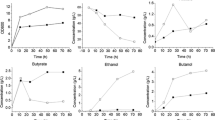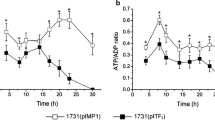Abstract
Development of a butanologenic strain with high selectivity for butanol production is often proposed as a possible route for improving the economics of biobutanol production by solventogenic Clostridium species. The acetoacetate decarboxylase (aadc) gene encoding acetoacetate decarboxylase (AADC), which catalyzes the decarboxylation of acetoacetate into acetone and CO2, was successfully disrupted by homologous recombination in solventogenic Clostridium beijerinckii NCIMB 8052 to generate an aadc − mutant. Our fermentation studies revealed that this mutant produces a maximum acetone concentration of 3 g/L (in P2 medium), a value comparable to that produced by wild-type C. beijerinckii 8052. Therefore, we postulated that AADC-catalyzed decarboxylation of acetoacetate is not the sole means for acetone generation. Our subsequent finding that non-enzymatic decarboxylation of acetoacetate in vitro, under conditions similar to in vivo acetone–butanol–ethanol (ABE) fermentation, produces 1.3 to 5.2 g/L acetone between pH 6.5 and 4 helps rationalize why various knock-out and knock-down strategies designed to disrupt aadc in solventogenic Clostridium species did not eliminate acetone production during ABE fermentation. Based on these results, we discuss alternatives to enhance selectivity for butanol production.







Similar content being viewed by others
References
Abeles RH, Frey PA, Jencks WP (1992) Biochemistry. Jones and Bartlett Publishers, Inc. Boston, MA. 476–483
Bahl H, Andersch W, Gottschalk G (1982) Continuous production of acetone and butanol by Clostridium acetobutylicum in a two-stage phosphate limited chemostat. Eur J Appl Microbiol Biotechnol 15:201–205
Chen CK, Blaschek HP (1999) Effect of acetate on molecular and physiological aspects of Clostridium beijerinckii NCIMB 8052 solvent production and strain degeneration. Appl Environ Microbiol 65:499–505
Clark SW, Bennett GN, Rudolph FB (1989) Isolation and characterization of mutants of Clostridium acetobutylicum ATCC824 deficient in acetoacetyl-coenzyme A: acetate/butyrate: coenzyme A-transferase (EC2.8.3.9) and in other solvent pathway. Appl Environ Microbiol 55:970–976
Cornillot E, Croux C, Soucaille P (1997) Physical and genetic map of Clostridium acetobutylicum ATCC 824 chromosome. J Bacteriol 179:7426–7434
Ezeji TC, Groberg M, Qureshi N, Blaschek HP (2003) Continuous production of butanol from starch-based packing peanuts. Appl Biochem Biotechnol 108:375–382
Ezeji TC, Qureshi N, Blaschek HP (2004) Acetone butanol ethanol (ABE) production from concentrated substrate: reduction in substrate inhibition by fed-batch technique and product inhibition by gas stripping. Appl Microbiol Biotechnol 63:653–658
Ezeji TC, Qureshi N, Blaschek HP (2005) Continuous butanol fermentation and feed starch retrogradation: butanol fermentation sustainability using Clostridium beijerinckii BA101. J Biotechnol 115:179–187
Ezeji TC, Qureshi N, Blaschek HP (2007) Bioproduction of butanol from biomass: from genes to bioreactors. Curr Opin Biotechnol 18:220–227
Ezeji T, Milne C, Price ND, Blaschek HP (2010) Achievements and perspectives to overcome the poor solvent resistance in acetone and butanol producing microbiologisms. Appl Microbiol Biotechnol 85:1697–1712
Gerischer U, Dürre P (1990) Cloning, sequencing, and molecular analysis of the acetoacetate decarboxylase gene region from Clostridium acetobutylicum. J Bacteriol 172:6907–6918
Hay RW, Bond MA (1967) Kinetics of the decarboxylation of acetoacetic acid. Aust J Chem 20:1823–1828
Heap JT, Pennington OJ, Cartman ST, Carter GP, Minton NP (2007) The ClosTron: a universal gene knock-out system for the genus Clostridium. J Microbiol Methods 70:452–464
Hüsemann MHW, Papoutsakis ET (1988) Solventogenesis in Clostridium acetobutylicum fermentations related to carboxylic-acid and proton concentrations. Biotechnol Bioeng 32:843–852
Jiang Y, Xu C, Dong F, Yang Y, Jiang W, Yang S (2009) Disruption of acetoacetate decarboxylase gene in solvent-producing Clostridium acetobutylicum increases the butanol ratio. Metab Eng 11:294–291
Jones DT, Woods DR (1986) Acetone-butanol fermentation revisited. Microbiol Rev 50:486–524
Kaltwasser M, Wiegert T, Schumann W (2002) Construction and application of epitope- and green fluorescent protein-tagging integration vectors for Bacillus subtilis. Appl Environ Microbiol 68:2624–2628
Lee JY, Jang Y-S, Lee J, Papoutsakis ET, Lee SY (2009) Metabolic engineering of Clostridium acetobutylicum M5 for highly selective butanol production. Biotechnol J 4:1432–1440
Mermelstein LD, Welker NE, Bennett GN, Papoutsakis ET (1992) Expression of cloned homologous fermentative genes in Clostridium acetobutylicum ATCC 824. Nat Biotechnol 10:190–195
Mermelstein LD, Papoutsakis ET, Petersen DJ, Bennett GN (1993) Metabolic engineering of Clostridium acetobutylicum ATCC824 for increased solvent production by enhancement of acetone formation enzyme activities using a synthetic acetone operon. Biotechnol Bioeng 42:1053–1060
Nemecek-Marshall M, Wojciechowski C, Wagner WP, Fall R (1999) Acetone formation in the Vibrio family: a new pathway for bacterial leucine catabolism. J Bacteriol 181:7493–7499
Sambrook J, Russell D (2001) Molecular Cloning: A Laboratory Manual. Cold Spring Harbor Laboratory Press, Cold Spring Harbor, NY
Shao L, Hu S, Yang Y, Gu Y, Chen J, Jiang W, Yang S (2007) Targeted gene disruption by use of a group II intron (Targetron) vector in Clostridium acetobutylicum. Cell Res 17:963–965
Tummala SB, Welker NE, Papoutsakis ET (2003a) Design of antisense RNA constructs for downregulation of the acetone formation pathway of Clostridium acetobutylicum. J Bacteriol 185:1923–1934
Tummala SB, Junne SG, Papoutsakis ET (2003b) Antisense RNA downregulation of coenzyme A transferase combined with alcohol-aldehyde dehydrogenase overexpression leads to predominantly alcohologenic Clostridium acetobutylicum fermentations. J Bacteriol 185:3644–3653
Wiesenborn DP, Rudolph FB, Papoutsakis ET (1989) Coenzyme A transferase from Clostridium acetobutylicum ATCC 824 and its role in the uptake of acids. Appl Environ Microbiol 55:323–329
Winnacker EL, Barker HA (1971) Aerobic metabolism of β-amino-n-butyric acid by Pseudomonas putida. Biochim Biophys Acta 237:284–292
Zhang C, Xing X-H, Lou K (2005) Rapid detection of a gfp-marked Enterobacter aerogenes under anaerobic conditions by aerobic fluorescence recovery. FEMS Microbiol Lett 249:211–218
Acknowledgments
This research was supported in part by the Ohio BioProducts Innovation Center (to TE), OARDC Seed Grant (to TE), Northeast Sun grant Initiative Award/Contract number GRT00012344 (to TE), and NSF grant MCB 0843543 (to VG).
Conflict of interest
The authors declare no conflict of interest.
Author information
Authors and Affiliations
Corresponding author
Electronic supplementary materials
Below is the link to the electronic supplementary material.
Figure S1
Acetic and butyric acid production by C. beijerinckii NCIMB 8052 and C. beijerinckii 8052aadc− in P2 medium (a, c) and P2 medium containing 4g/L CaCO3 (b, d). Acid variations during growth of C. beijerinckii NCIMB 8052 and C. beijerinckii 8052aadc− indicate continuous production and re-assimilation of acetic and butyric acid during ABE fermentation (DOC 580 kb)
Rights and permissions
About this article
Cite this article
Han, B., Gopalan, V. & Ezeji, T.C. Acetone production in solventogenic Clostridium species: new insights from non-enzymatic decarboxylation of acetoacetate. Appl Microbiol Biotechnol 91, 565–576 (2011). https://doi.org/10.1007/s00253-011-3276-5
Received:
Revised:
Accepted:
Published:
Issue Date:
DOI: https://doi.org/10.1007/s00253-011-3276-5




